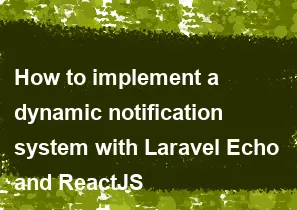How to implement a dynamic notification system with Laravel Echo and ReactJS

Implementing a dynamic notification system with Laravel Echo and ReactJS involves setting up a real-time messaging system using Laravel Echo for the server-side and integrating it with ReactJS on the client-side. Laravel Echo is a library that makes it easy to implement WebSockets and real-time features in your Laravel application.
Here's a step-by-step guide on how you can achieve this:
Prerequisites:
Make sure you have Laravel and Node.js installed on your machine.
Set up a Laravel project and configure Laravel Echo.
Step 1: Install Laravel Echo and Socket.IO
Install the necessary packages for Laravel Echo and Socket.IO by running the following commands in your Laravel project:
bashcomposer require pusher/pusher-php-server npm install --save laravel-echo pusher-js
Step 2: Configure Laravel Echo
In your Laravel project, update the broadcasting.php configuration file with your Pusher credentials. Update the config/broadcasting.php file:
php'connections' => [
'pusher' => [
'driver' => 'pusher',
'key' => env('PUSHER_APP_KEY'),
'secret' => env('PUSHER_APP_SECRET'),
'app_id' => env('PUSHER_APP_ID'),
'options' => [
'cluster' => env('PUSHER_APP_CLUSTER'),
'encrypted' => true,
],
],
],
Set your Pusher credentials in the .env file:
dotenvPUSHER_APP_ID=your-app-id PUSHER_APP_KEY=your-app-key PUSHER_APP_SECRET=your-app-secret PUSHER_APP_CLUSTER=your-app-cluster
Step 3: Create a Notification Event
Create a new Laravel event for your notification. For example, if you are creating a notification for new messages, you can create an event like this:
bashphp artisan make:event NewMessageNotification
In the generated NewMessageNotification.php file, you can define the broadcast event:
phppublic $message;
public function __construct($message)
{
$this->message = $message;
}
public function broadcastOn()
{
return new Channel('new-message-channel');
}
Step 4: Trigger the Event
In your controller or wherever you want to trigger the event (e.g., when a new message is created), broadcast the event:
phpevent(new NewMessageNotification('New message content'));
Step 5: Set Up Echo in ReactJS
Install the required packages for ReactJS:
bashnpm install --save laravel-echo pusher-js
In your ReactJS component, set up Laravel Echo:
jsximport Echo from "laravel-echo";
window.Pusher = require("pusher-js");
const echo = new Echo({
broadcaster: 'pusher',
key: process.env.REACT_APP_PUSHER_APP_KEY,
cluster: process.env.REACT_APP_PUSHER_APP_CLUSTER,
encrypted: true,
});
Step 6: Listen for the Event in ReactJS
In your ReactJS component, listen for the broadcasted event and update your UI accordingly:
jsxuseEffect(() => {
echo.channel('new-message-channel')
.listen('NewMessageNotification', (event) => {
// Update your UI or trigger a notification
console.log('New Message:', event.message);
});
return () => {
// Unsubscribe from the channel when component unmounts
echo.leave('new-message-channel');
};
}, []);
Step 7: Start Laravel Echo Server
Run the Laravel Echo server to handle WebSocket connections:
bashphp artisan websockets:serve
Step 8: Start ReactJS Application
Run your ReactJS application to test the real-time notification system.
bashnpm start
Now, whenever you trigger the NewMessageNotification event in your Laravel application, your ReactJS component will receive the notification in real-time.
Remember to handle authentication and security considerations when implementing a real-time system in a production environment. Additionally, this example uses Pusher as the broadcasting driver, but you can choose other drivers based on your requirements.
-
Popular Post
- How to optimize for Google's About This Result feature for local businesses
- How to implement multi-language support in an Express.js application
- How to handle and optimize for changes in mobile search behavior
- How to handle CORS in a Node.js application
- How to use Vue.js with a UI framework (e.g., Vuetify, Element UI)
- How to configure Laravel Telescope for monitoring and profiling API requests
- How to create a command-line tool using the Commander.js library in Node.js
- How to implement code splitting in a React.js application
- How to use the AWS SDK for Node.js to interact with various AWS services
- How to use the Node.js Stream API for efficient data processing
- How to implement a cookie parser middleware in Node.js
- How to implement WebSockets for real-time communication in React
-
Latest Post
- How to implement a dynamic form with dynamic field styling based on user input in Next.js
- How to create a custom hook for handling user interactions with the browser's device motion in Next.js
- How to create a custom hook for handling user interactions with the browser's battery status in Next.js
- How to implement a dynamic form with dynamic field visibility based on user input in Next.js
- How to implement a dynamic form with real-time collaboration features in Next.js
- How to create a custom hook for handling user interactions with the browser's media devices in Next.js
- How to use the useSWRInfinite hook for paginating data with a custom loading indicator in Next.js
- How to create a custom hook for handling user interactions with the browser's network status in Next.js
- How to create a custom hook for handling user interactions with the browser's location in Next.js
- How to implement a dynamic form with multi-language support in Next.js
- How to create a custom hook for handling user interactions with the browser's ambient light sensor in Next.js
- How to use the useHover hook for creating interactive image zoom effects in Next.js